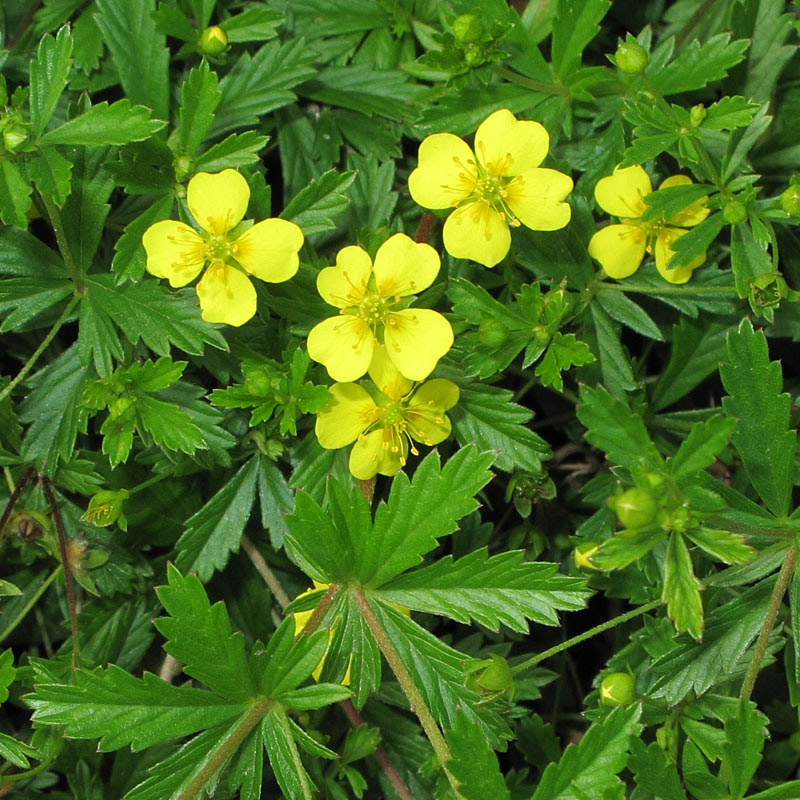Botanical name
Potentilla erecta (L.) Raeusch.
[Syn. Potentilla tormentilla (Crantz.) Neck.]
Family
Rosaceae
Common name
Tormentil, Septfoil, Erect cinquefoil, Bloodroot
Information about the plant
The tormentil or erect cinquefoil is very diverse with four varieties and is widespread throughout Europe and northern Asia, presumably having immigrated to eastern North America. It grows as a rhizome perennial on wet and dry meadows, on heaths, and in forests. The rhizome (rootstock) is an underground shoot from which the plant sprouts anew after winter, ensuring its survival. Many small roots grow from the rhizome deeper into the soil. The rhizome of the bloodroot is bulbous to cylindrical, dark brown on the outside, and quickly turns reddish on the cut surfaces. When dried, the rhizome is reddish-brown, which has earned the plant the name "bloodroot". The name may also come from its earlier popular use to promote blood clotting. The "tormentil red" contained in it (reddish-brown oxidation products of the catechin tannins) was thought to be responsible for this.
The genus name Potentilla is probably derived from the Latin 'potentia' (= power), complemented by the diminutive form '-illa'. This refers to the healing power attributed to several species in the sense of "small, medicinal herb". However, this derivation is not certain. The species epithet erecta (Latin 'erectus' = upright) describes the upright shoot. The synonymous species epithet tormentilla is derived from the Latin 'tormentum' (= torment, plague), with the diminutive adapted to the genus name Potentilla.
The basal leaves of the tormentil are trifoliate, the individual leaflets are wedge-shaped, coarsely serrated with protruding terminal teeth. The stem leaves also have two finger-like incised stipules, giving them a "five-toothed" appearance. The flowers are in a few-flowered, loose inflorescence. They consist of 4 bright yellow petals, which rise above the sepals. In the center - as is characteristic of the rose family - there are many (14 to 20) stamens around the carpels. Flowering time is from May to August.
Medicinally used parts of plants (herbal drug)
The dried rhizome (Tormentillae rhizoma), which has been removed from the roots, is used.
The commercially available drug comes from Eastern European countries.
Constituents of the herbal drug
Tormentil rootstock contains tannins (up to 22%, mainly catechin tannins), triterpenes (tormentoside) and caffeic acid derivatives.
Quality of the drug
The quality of the following drugs or drug preparations is specified in the European Pharmacopoeia (Ph. Eur.):
- Tormentilla rootstock (Tormentillae rhizoma)
- Tormentilla tincture (Tormentillae tinctura)
Medical applications
Recognised medical use
The HMPC has classified tormentil rhizome as a traditional herbal medicinal product (see "Traditional use").
ESCOP: Internally for non-specific, acute diarrheal diseases and supportive for acute and chronic intestinal inflammation; externally for slight irritations of the mucosa of the mouth and throat; these indications are based on human experience and long-standing use.
Traditional use
Tormentil rootstock has been classified by the HMPC as a traditional herbal medicinal product (Article 16a of Directive 2001/83/EC). Based on long-standing use, tormentil rhizome can be used internally to treat mild diarrhea and and the herbal tea and some liquid preparations for minor inflammation of the lining of the mouth.
Herbal drug preparations in finished dosage forms
- Chopped or powdered tormentil rhizome for tea preparation
- Dry extracts in coated tablets and capsules
- Tincture in drops and mouth rinses
- Alcoholic extracts in drops and mouth rinses
Dosage
Tea: drink a cup of tormentil rootstock tea 3 to 4 times a day between meals. The average daily dose is 6 g of the drug. The tea can also be used as a mouthwash and gargle.
Preparation of a tea
2 to 3 g of finely chopped or powdered tormentil rhizome is added to approx. 150 mL of cold water, briefly heated to the boiling point, and then strained after a short infusion.
As tannins can decompose when heated, which reduces their effect, a cold-water extract (preparation in cold water) is also recommended; however, the preparation is then left to infuse for a longer time.
Notes
Medical advice must be sought in the case of prolonged and recurring diarrhea and bloody stools.
No data is available on the use of tormentil rootstock during pregnancy and lactation. The use in children and adolescents under the age of 18 is not recommended due to a lack of evidence.
Side effects
Allergic reactions and mild gastrointestinal complaints may occasionally occur.
Interactions
When tormentil rootstock is taken internally, the absorption of concomitantly administered medications may be delayed. Tormentil rootstock should, therefore, be taken at least one hour before or after taking other medications.
References
Herbal drug monographs
HMPC (2011, 2020), ESCOP (2013)
Further literature
Commentary on the European Pharmacopoeia (tormentil rhizome, No. 1478; tormentil tincture, No. 1895)


